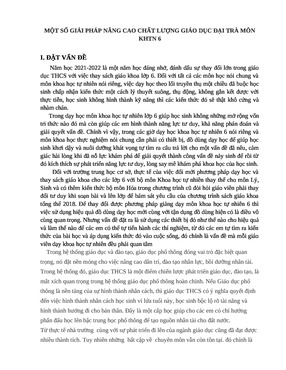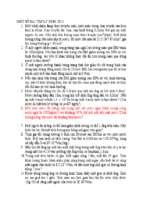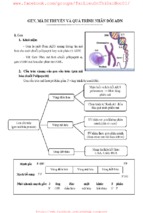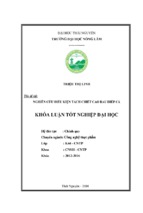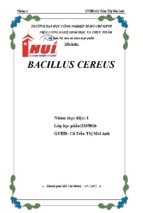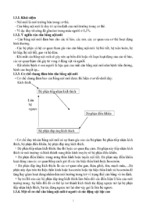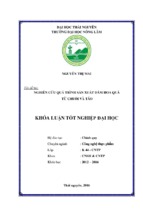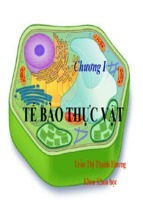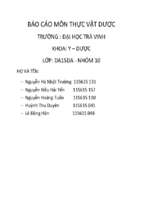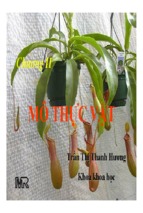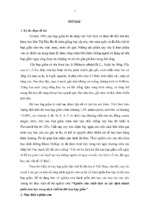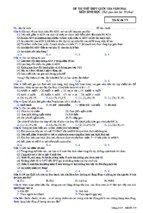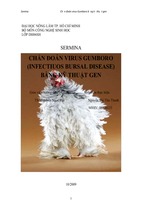ứng dụng của vi sinh vật trong công nghệ sinh học, trong công nghiệp...
Sanjai Saxena
Applied
Microbiology
Applied Microbiology
Sanjai Saxena
Applied Microbiology
Sanjai Saxena
Department of Biotechnology
Thapar University
Patiala, Punjab, India
ISBN 978-81-322-2258-3
ISBN 978-81-322-2259-0
DOI 10.1007/978-81-322-2259-0
(eBook)
Library of Congress Control Number: 2015931517
Springer New Delhi Heidelberg New York Dordrecht London
© Springer India 2015
This work is subject to copyright. All rights are reserved by the Publisher, whether the whole or
part of the material is concerned, specifically the rights of translation, reprinting, reuse of
illustrations, recitation, broadcasting, reproduction on microfilms or in any other physical way,
and transmission or information storage and retrieval, electronic adaptation, computer software,
or by similar or dissimilar methodology now known or hereafter developed.
The use of general descriptive names, registered names, trademarks, service marks, etc. in this
publication does not imply, even in the absence of a specific statement, that such names are
exempt from the relevant protective laws and regulations and therefore free for general use.
The publisher, the authors and the editors are safe to assume that the advice and information in
this book are believed to be true and accurate at the date of publication. Neither the publisher nor
the authors or the editors give a warranty, express or implied, with respect to the material
contained herein or for any errors or omissions that may have been made.
Printed on acid-free paper
Springer (India) Pvt. Ltd. is part of Springer Science+Business Media (www.springer.com)
Preface
Microorganisms appeared on the face of the earth around 3.5 billion years
ago and evolved in due course of time in two clearly distinguishable forms –
prokaryotes and eukaryotes. Eukaryotic microorganisms possess membrane
bound cell organelles and comprise of fungi and protists, while prokaryotes
lack membrane bound cell organelles and include eubacteria and the archaebacteria. Initially prokaryotic microorganisms dominated the earth, but during the course of their evolution they transformed the earth’s anaerobic
environment into aerobic and simultaneously generated massive amounts of
organic compounds. Thus these evolved forms of prokaryotes created an
environment suited for the evolution and maintenance of more complex life
forms.
Microorganisms exhibit metabolic plasticity i.e. they adapt and survive
changes which occur in the biosphere and therefore are ubiquitous in their
existence as compared to the complex life forms. Advances in biochemistry,
molecular biology and physiology have provided us tools to understand the
genetic and metabolic makeup of microorganisms which have evolved in due
course of time for their successful exploitation. Thousands of microorganisms have been recovered from different niche and are available as pure cultures in different culture collections across the globe while thousands are still
to be explored or cultured.
Applied microbiology is primarily associated with exploitation of these
microorganisms directly or indirectly in processes and products that are of
economic, environmental and social importance throughout the world.
Knowledge related to genetic engineering has revolutionized applied microbiology by enhancing the desired traits and removing the undesired traits
from microorganisms thereby enhancing their commercial applicability.
Today microorganisms are playing a key role in the production of a variety
of products via fermentation processes which include production of enzymes
for use in commercial products like detergents, medicines, personal care
products etc., chemical feedstocks, foods and pharmaceuticals.
Microorganisms also play an important role in agricultural practices as well
as remediating the environment. The purpose of this book is to provide a
consolidated resource on practical exploitation of microorganisms in different fields like agriculture, environment, food, chemical and pharmaceuticals.
The 12 chapters provide an in-depth understanding of the knowledge related
to the specified field with practical approach. This book is specifically targeted
v
Preface
vi
for undergraduates and postgraduates who take up practical research in their
degree programs. It will also prove to be a useful resource book for research
institutes.
The inspiration to write this book is primarily students who have been
striving hard to find consolidated information accompanied with industrial
aspects. There has been a long-felt need for a comprehensive book on the
application of biotechnological processes by exploitation of microorganisms
by undergraduate and postgraduate students and researchers. This book is
first of its kind meeting this requirement. I have attempted to prepare a suitable textbook by using a direct approach that should be very useful for
students.
Patiala, India
Sanjai Saxena
Acknowledgments
I would like to thank Dr. Devendra Kumar, my father, who has provided
immense help in careful reading and editing of the manuscript. I am also
thankful to Dr. Mamta Kapila, Springer for her interest in my proposal for
this book and for introducing it to Springer..
I also acknowledge constant encouragement of my mother for writing this
book. My wife and my daughter have been a constant inspiration and great
support to make this project possible.
vii
Contents
1
Diversity of Industrially Relevant Microbes ..............................
1.1 Introduction .........................................................................
1.2 Realm of Microbial Existence .............................................
1.2.1 Diversity of Soil Microbes .....................................
1.2.2 Marine Microbial Diversity ...................................
1.2.3 Halophilic Environment .........................................
1.2.4 Plant: Microbe Interaction .....................................
1.2.5 Microbe–Microbe Interactions...............................
1.2.6 Animal–Microbe Interactions ................................
1.3 Summary .............................................................................
Selected Reading ............................................................................
1
1
1
2
3
6
6
8
8
9
9
2
Microbial Technology and Biotechnology ..................................
2.1 Introduction .........................................................................
2.2 Healthcare Industry and GMMOs .......................................
2.3 GMMOs in Agriculture .......................................................
2.4 Role of GMMOs in Chemical Industry ...............................
2.5 GMMOs in Textile Industry ................................................
2.6 Environmental Applications of GMMOs ............................
2.7 Food Industry and the Role of GMMOs .............................
2.8 GMMOs for Bioethanol Production ....................................
2.9 Summary .............................................................................
Selected Reading ............................................................................
13
13
14
15
15
16
16
17
17
18
18
3
Fermentation Technology ............................................................
3.1 Introduction .........................................................................
3.2 Batch Fermentation .............................................................
3.3 Continuous Fermentation ....................................................
3.4 Fed-Batch Fermentation ......................................................
3.4.1 Fixed-Volume Fed-Batch .......................................
3.4.2 Variable-Volume Fed-Batch ...................................
3.5 Components in a Typical Bioreactor ...................................
3.6 Types of Submerged Bioreactors.........................................
3.6.1 Stirred Tank Fermenter (STF) ................................
3.6.2 Airlift Fermenter (ALF) .........................................
3.6.3 Bubble Column Fermenter (BCF) .........................
3.7 Solid Substrate Fermentation ..............................................
19
19
19
22
22
22
23
23
25
25
26
26
26
ix
Contents
x
3.8 Role of Bioreactor in Solid Substrate Fermentation ...........
3.9 Types of Solid Substrate Bioreactors ..................................
3.10 Media for Industrial Fermentations .....................................
3.11 Downstream Processing ......................................................
3.12 Summary .............................................................................
Selected Reading ............................................................................
28
28
30
32
34
34
Agricultural Applications of Microbes .......................................
4.1 Introduction .........................................................................
4.2 Biofertilisers ........................................................................
4.2.1 Nitrogen-Fixing Microorganisms
as Biofertilisers ......................................................
4.2.2 Phosphate Solubilising Microorganisms
as Biofertilisers ......................................................
4.2.3 PGPB (Plant Growth Promoting Bacteria):
Plant Growth Promoters .........................................
4.3 Biopesticides .......................................................................
4.3.1 Bio-weedicides.......................................................
4.3.2 Bioinsecticides .......................................................
4.3.3 Biofungicides .........................................................
4.4 Precincts of Biological Control ...........................................
4.5 Biorational Pesticides of Microbial Origin .........................
4.5.1 Bacterial Secondary Metabolites
as Agrochemicals ...................................................
4.5.2 Agroactive Compounds
from Actinomycetes ...............................................
4.5.3 Fungal Secondary Metabolites
as Agrochemical .....................................................
4.6 Summary .............................................................................
Selected Reading ............................................................................
37
37
37
5
Environment and Microbes .........................................................
5.1 Introduction .........................................................................
5.2 Microbial Bioremediation ...................................................
5.2.1 In Situ Bioremediation by Microbes ......................
5.2.2 Ex Situ Bioremediation by Microbes .....................
5.3 Biodegradation of Xenobiotic Compounds .........................
5.4 Bioremediation of Heavy Metals ........................................
5.5 Biomining ............................................................................
5.5.1 Extraction of Copper ..............................................
5.5.2 Extraction of Uranium ...........................................
5.5.3 Extraction of Gold..................................................
5.6 Microbially Enhanced Oil Recovery (MEOR) ....................
5.7 Summary .............................................................................
Selected Reading ............................................................................
55
55
55
55
56
57
58
60
61
61
62
62
63
63
6
Microbes in the Food Industry ....................................................
6.1 Introduction .........................................................................
6.2 Fermented Foods .................................................................
6.2.1 Milk Products .........................................................
65
65
65
65
4
37
39
40
41
42
43
46
46
48
48
48
49
52
53
Contents
xi
7
8
6.2.2 Fermented Vegetables ............................................
6.2.3 Fermented Meat Preparations ................................
6.2.4 Traditional Fermented Food...................................
6.2.5 Bakery Products .....................................................
6.3 Fermented Beverages ..........................................................
6.3.1 Wine .......................................................................
6.3.2 Beer ........................................................................
6.3.3 Whiskey .................................................................
6.3.4 Kombucha ..............................................................
6.4 Summary .............................................................................
Selected Reading ............................................................................
67
67
67
67
68
68
68
69
69
69
69
Microbes in Production of Commodity Chemicals ...................
7.1 Introduction .........................................................................
7.2 Commercial Production of Ethanol .....................................
7.3 Industrial Production of Acrylamide ...................................
7.4 Industrial Production of Citric Acid ....................................
7.4.1 Citric Acid Production by Surface
Fermentation ..........................................................
7.4.2 Submerged Fermentation for Citric
Acid Production .....................................................
7.4.3 Solid–Substrate Fermentation for Citric
Acid Production .....................................................
7.4.4 Recovery of Citric Acid .........................................
7.5 Microbial Production of Adipic Acid ..................................
7.6 Microbial Production of 1, 2-Propanediol...........................
7.7 Penicillin as a Commodity Chemical ..................................
7.7.1 Production of Penicillin .........................................
7.7.2 Recovery and Purification of Penicillin .................
7.8 Summary .............................................................................
Selected Reading ............................................................................
71
71
71
73
75
Microbes in Production of Fine Chemicals (Antibiotics,
Drugs, Vitamins, and Amino Acids) ............................................
8.1 Introduction .........................................................................
8.2 Pharmaceutical Fine Chemicals ..........................................
8.2.1 Antibiosis and Antibiotics ......................................
8.2.2 Discovery of Penicillin: Beginning
of the Antibiotic Era ...............................................
8.2.3 Antibiotics Discovered from Fungi........................
8.2.4 Actinomycetes in Antibiotic Discovery .................
8.2.5 Antibiotics Discovered from Bacteria....................
8.2.6 Microorganisms Producing Other
Pharmaceutically Active Metabolites.....................
8.2.7 Endophytic Microbes as Sources of Putative
Phytochemicals ......................................................
8.3 Engineering Microbes in the Production
of Plant Products .................................................................
8.3.1 Isoprenoid Biosynthesis Engineering ....................
76
76
77
78
78
79
79
80
80
80
80
83
83
83
83
85
85
89
91
93
97
100
100
Contents
xii
8.4
9
Microbial Synthesis of Vitamins .........................................
8.4.1 Vitamin E ...............................................................
8.4.2 Vitamin K ...............................................................
8.4.3 β -Carotene (Provitamin A) ....................................
8.4.4 Vitamin B2 ..............................................................
8.4.5 Vitamin B12.............................................................
8.5 Production of Amino Acids .................................................
8.5.1 Ajinomoto Process of Fermentative
Production of L-Glutamate .....................................
8.5.2 Fermentative Production of L‐Lysine .....................
8.6 Microbes in the Production of Dyes and Pigments .............
8.6.1 Microbial Pigments in the Textile Industry............
8.6.2 Microbial Pigments in the Food Industry ..............
8.7 Microbial Production of Flavors and Fragrances ................
8.8 Summary .............................................................................
Selected Reading ............................................................................
102
102
104
104
105
106
108
Microbial Enzymes and Their Industrial Applications.............
9.1 Introduction .........................................................................
9.1.1 Advantages of Microbial Enzymes ........................
9.1.2 Modest Beginnings of Enzyme Technology ..........
9.2 Microbial Enzymes: Diversity and Exploitation .................
9.3 Application of Microbial Enzymes: Broad Avenues ...........
9.3.1 Therapeutic Agents ................................................
9.3.2 Diagnostics.............................................................
9.4 Chemical Industry ...............................................................
9.4.1 Cell-Free Biocatalysis ............................................
9.4.2 Whole Cell Biocatalysis.........................................
9.4.3 Phytochemical Extraction with
Microbial Enzymes ................................................
9.5 Food and Feed Industry .......................................................
9.5.1 Acetolactate Decarboxylase ...................................
9.5.2 Amylases ................................................................
9.5.3 α -Galactosidase .....................................................
9.5.4 Cellulases ...............................................................
9.5.5 Dextranases and Invertases ....................................
9.5.6 Keratinases .............................................................
9.5.7 Lipases ...................................................................
9.5.8 Naringinases...........................................................
9.5.9 Pectinases ...............................................................
9.5.10 Phytases..................................................................
9.5.11 Tannases .................................................................
9.5.12 Transglutaminase ...................................................
9.6 Detergent .............................................................................
9.6.1 Proteases ................................................................
9.6.2 Use of Microbial Lipase as
Detergent Additive .................................................
9.6.3 Amylases as Detergent Additive ............................
121
121
121
122
123
124
125
130
130
131
132
109
110
111
111
112
113
115
116
133
134
135
135
135
135
136
136
137
138
138
139
139
139
140
140
141
142
Contents
xiii
9.6.4
Other Enzymes Used in Detergent
Formulations ..........................................................
9.7 Textile Industry....................................................................
9.8 Leather Industry ..................................................................
9.9 Pulp and Paper Processing ..................................................
9.10 Biofuels ...............................................................................
9.11 Personal Care Products........................................................
9.12 Summary .............................................................................
Selected Reading ............................................................................
10 Strategies of Strain Improvement of Industrial Microbes........
10.1 Introduction .........................................................................
10.2 Spontaneous Mutations .......................................................
10.3 Classical Mutagenesis .........................................................
10.4 Mutant Selection in Classical Mutagenesis .........................
10.4.1 Morphological Mutants..........................................
10.4.2 Auxotrophic Mutants .............................................
10.4.3 Mutants Exhibiting Resistance to
Antimetabolites ......................................................
10.4.4 Enhanced Production of the End Product:
Agar Zone Mutants ................................................
10.5 Recombination ....................................................................
10.6 Recombinant DNA Technology ..........................................
10.7 Integrated Strain Improvement: Precision
Engineering Technology......................................................
10.7.1 Production of High Lovastatin-Producing
Strains Through Precision Engineering .................
10.8 Summary .............................................................................
Selected Reading ............................................................................
143
143
145
147
149
150
151
151
155
155
155
156
158
160
160
160
161
162
163
166
167
168
169
11 Vaccines and Their Production ...................................................
11.1 Introduction .........................................................................
11.2 Traditional Vaccines ............................................................
11.2.1 Live Attenuated Vaccines .......................................
11.2.2 Dead, Inactivated Vaccines.....................................
11.2.3 Toxoids ...................................................................
11.2.4 Pathogen-Derived Antigens ...................................
11.3 Modern Vaccines .................................................................
11.3.1 Subunit Vaccines ....................................................
11.3.2 Conjugate Vaccines ................................................
11.3.3 Recombinant Vaccines ...........................................
11.3.4 Peptide Vaccines.....................................................
11.4 Summary .............................................................................
Selected Reading ............................................................................
173
173
173
173
174
174
174
175
176
176
177
178
178
178
12 Immobilisation and Biosensors ...................................................
12.1 Introduction .........................................................................
12.2 Strategies of Whole Cell Immobilisation ............................
12.2.1 Adsorption..............................................................
179
179
179
179
Contents
xiv
12.2.2 Covalent Binding ...................................................
12.2.3 Cell to Cell Cross-Linking .....................................
12.2.4 Encapsulation .........................................................
12.2.5 Entrapment .............................................................
12.3 Alginate Method of Whole Cell Immobilisation .................
12.4 Microbes as Biosensors .......................................................
12.4.1 Microbial Electrochemical Biosensors ..................
12.4.2 Optical Microbial Biosensors ................................
12.5 Summary .............................................................................
Selected Reading ............................................................................
180
181
181
182
183
184
185
186
188
188
About the Author
Sanjai Saxena currently is an Associate Professor in the Department of
Biotechnology, Thapar University, Patiala, India. Concurrently Dr. Saxena is
also Coordinator of TIFAC-Centre of Relevance & Excellence (CORE) in
Agro & Industrial Biotechnology, in the University. Dr. Saxena possess over
15 years of research and teaching experience in microbial secondary metabolites, microbial biochemistry, microbial diversity, biological control, mycology and drug discovery. His research work has resulted in significant
extramural funding, over 35 refereed journal articles, 25 abstracts, 5 book
chapters, and 1 US and 2 Indian patents. Recognizing his work, the Association
of Advancement of Biodiversity Science, Karnataka, has conferred upon him
Eminent Microbiologist Award in the year 2014 and inducted him as a fellow
in the society.
xv
1
Diversity of Industrially Relevant
Microbes
1.1
Introduction
The discovery of the microbial world is much
attributed to van Leeuwenhoeck (1677) who
observed and described single-celled organisms
which he originally referred to as animalcules
with his handcrafted microscopes. However, the
different activities and functions of these organisms were identified after approximately 200
years later while performing fermentations,
understanding diseases in humans and animals
and in agriculture. Incidentally the term microbe
was given by Prof. Charles E. Sedillot (1804–
1833) who is one of the pioneers of modern
medicine, surgery, anaesthesiology, histopathology and infectiology. Sedillot understood the
existence and action of microorganisms which he
termed as microbes while studying the development of post-operative infections. Pasteur
demonstrated that there are specific activities of
yeasts and bacteria which are responsible for specific fermentations which he published in papers
between 1857 and 1860. He was able to demonstrate the development of wine diseases and role
of pasteurisation to preserve wine storage.
Martinus W. Beijerinck was one of the great
general microbiologists who made fundamental
contributions to microbial ecology by highlighting microbial association with plants for fixing
the atmospheric nitrogen. He isolated the aerobic
nitrogen fixing microorganism Azotobacter as
well as root nodule organism Rhizobium. The
first microbe (prokaryote) evolved around 3.6
S. Saxena, Applied Microbiology,
DOI 10.1007/978-81-322-2259-0_1, © Springer India 2015
billion years ago and since then has undergone a
process of evolution by exploiting a vast range of
energy sources and thriving in different habitats
which existed during the course of evolution. All
the basic biochemical processes of the life
evolved and developed from their microbial
ancestors. Microbes are considered to be the
common ancestors of all organisms which not
only grow everywhere but are present in abundance. Microorganisms correspond to the richest
collection of molecular and chemical diversity.
They drive the ecosystem processes by maintaining the nutrient cycles as well as maintain elegant
relationships between themselves and higher
organisms. Microbial diversity is a great resource
of biotechnological exploration of novel microorganisms and their products for exploitation in
different processes. Microbial diversity has been
explored using several approaches like phylogeny,
physiology, metabolism and genomics.
1.2
Realm of Microbial Existence
Microbial diversity from six different environments has been studied using culture-dependent
and culture-independent methods. Microbial
communities in coastal subsurface sediments are
scarcely investigated and have escaped attention
so far (Kopke et al. 2005). The study of marine
microbial biodiversity is vital to the understanding of the different processes of the ocean, which
may present potent novel microorganisms for
1
1
2
screening of bioactive compounds. As the
microbial communities have a complex ecosystem process, biodiversity study explores their
distribution and roles in the habitat. Endophytic
existence of microbes has become a new resource
for their exploitation in new processes and
development of novel products. Extremophilic
environments are also new niches for exploration
and identification of new microbes on the basis of
their physiological and phylogenetic uniqueness.
These have been exploited in screening of
enzymes, biopolymers and antibiotics for industrial applications.
1.2.1
Diversity of Soil Microbes
Soil is a very complex habitat dominated by
microbes which exist on solid phase. It is
estimated that a gram of undisturbed soil may
contain ten billion microorganisms representing
6,000–10,000 different genomes. Associating
microbial diversity with soil functions is a very
complex situation since it is not possible to assess
the microbial diversity despite using molecular
tools and techniques which have been lately used
for viable but not cultivable microorganisms.
Natural products isolated from soil samples play
a significant role in discovery and development
of new drugs and biocatalysts. The novel
cultivation technologies like gene mining by
direct cloning of soil DNA and screening of the
resulting complex metagenomic libraries have
lead to increase the discovery rate of new biomolecules and minimise the re-evaluation of already
known natural products. The use of different isolation parameters, viz. pH, salt, temperature and
metal concentration, has enhanced the identification of distinct microbial type which have an
altered physiology and genetic mechanisms of
overcoming or tolerating different physical as
well as chemical stresses. These microbes can be
explored for their abilities to produce novel
enzymes as well as clinically important drugs.
Plants also have a significant impact on the
microbial composition of soil in the rhizosphere
due to rhizodeposition and decay of litter roots.
Microbes especially bacteria are attracted to
Diversity of Industrially Relevant Microbes
aromatic pollutants like naphthalene, benzene
and chlorinated herbicides as a precedent to their
degradation. The terms biodegradation, biocatalysis and biotransformations have been used
interchangeably depending on the aspect of
chemical transformations being carried out by
these microorganisms. Biocementation is a process of enhancement of the strength and stiffness
of properties of soil and rocks through microbial
activity or products. Chemical grouting is a
process to fill soil voids with fluid grouts. Waterinsoluble gel-forming biopolymers of microbial
origin such as xanthan, chitosan, polyglutamic
acid, sodium alginate and polyhydroxybutyrate
can also be used as grouts for soil erosion control,
enclosing of bioremediation zone and mitigating
soil liquefaction (Momemi et al. 1999; Etemadi
et al. 2003; Gioia and Ciriello 2006).
A variety of molecular methods like ARDRA,
DGGE, TGGE or RISA have been developed to
assess the bacterial diversity in the soil. However,
fungal diversity in the soil could not be studied
using the same techniques since the concentration of fungal DNA is much less than that of
bacterial DNA. Another hindrance has been the
use of specific primers without co-amplification
of DNA from other eukaryotic organisms such as
plants, algae and nematodes. Soil is a vast
playground of interactions within different types
of microbes which lead to microbial community
development. The various interactions are
(1) neutral associations, (2) positive associations
and (3) negative associations.
1.2.1.1 Neutral Associations
Neutralism or neutral association between
microbes refers to the occupation of two different
species of microbes in the same environment
without affecting each other. This type of
association is generally transitory in nature.
1.2.1.2 Positive Associations
Positive associations comprise of mutualism,
syntrophism and commensalism. Mutualism is
essentially a relationship in which each organism
is benefitted from the association. Syntrophism is
a mutualistic association which involves the
exchange of nutrition between two species.
1.2
Realm of Microbial Existence
Lichen, an association between fungus and
blue-green algae, is an example of syntrophism.
Mutualistic interaction between Thiobacillus
ferrooxidans and Beijerinckia lacticogenes helps
in ore leaching. Leaching is the process of
recovering metal from the ore, where microorganisms play the important role of oxidising
insoluble metal sulphides to soluble sulphates.
Microorganisms may also form mutualistic relationships with plants in soil, an example of which
is nitrogen-fixing bacteria, i.e. Rhizobium,
growing in the roots of legumes (plants of the
family Leguminosae). In this Rhizobium–legume
association, Rhizobium bacteria are benefited by
protection from the environmental stresses while
in turn the plant is benefited by getting readily
available nitrate nitrogen released by the bacterial
partner.
Commensalism refers to a relationship
between organisms in which one species of a pair
benefits whereas the other is not affected. This
happens commonly in soil with respect to degradation of complex molecules like cellulose and
lignin. For example, many fungi can degrade cellulose to glucose, which is utilised by many bacteria. Many bacteria are unable to utilise cellulose,
but they can utilise the fungal breakdown products of cellulose, e.g. glucose and organic acids.
1.2.1.3 Negative Associations
The negative associations comprise of antagonism, competition, parasitism and predation.
Antagonistic relationship between microorganisms generally results in inhibition or adversely
affects the growth and survival of other species.
This is generally mediated by signal molecules
which induce the inhibition or adverse effects
and have been referred to as antibiotics, and this
phenomenon is known as antibiosis. This interaction has a great importance in the discovery and
development of a variety of antimicrobial drugs.
Soil-dwelling Streptomyces species has fuelled in
the development of an array of antibacterial and
antifungal antibiotics like streptomycin, griseofulvin, neomycin, cycloheximide, etc.
Competition refers to the interaction between
microorganisms for limited nutrients and space.
In this interaction, a microorganism which out-
3
competes or eliminates other for the limited
resource in lesser time is found to predominate.
Microorganisms exhibiting adaptability and
faster growth rate are better competitors. A relationship in which one organism lives in or on
other organism is referred to as parasitism. The
parasite lives in intimate physical contact with
the host and forms metabolic association with the
host. Mycoparasites and presumptive mycoparasites have biocontrol potential; some are responsible for the natural suppressiveness of soils to
certain plant pathogens. Trichoderma and
Gliocladium virens have been successfully used
as commercial biofungicides to control a range of
economically important soil borne fungal plant
pathogens.
Several species of Trichoderma were used
successfully against certain pathogenic fungi.
Trichoderma sp. was used as commercial biofungicides to control a range of economically important soilborne fungal plant pathogens.
1.2.2
Marine Microbial Diversity
Oceans and sea contribute to the largest ecosystem on the Earth which has a profound effect on
the world’s climate. Microorganisms have been
evolving since the last 3.8 Ga (109 years) of their
4.6 Ga existence and have made Earth habitable
for all other species. Hence, the interactions of
these organisms with other life forms and their
diversity have been frequently questioned.
As compared to the plant and animal diversity,
microbial diversity research is difficult, and the
role of microbiologist is very crucial in
understanding their diverse assemblages.
Microbial diversity in marine ecosystem has been
ventured into a couple of decades ago, and hitherto unknown groups of microorganisms have
been identified (Zobell 1946; Wood 1959).
Marine microorganisms occur in vast number
(Box 1.1). Ocean water contains up to 106–109
microorganisms per ml of several thousand
different types. The direct interactions of marine
microorganisms with other organisms have been
distributed in two broad classes, viz. pathogenic
and symbiotic.
1
4
Box 1.1: Marine Microorganism
Any microorganism that grows in marine
environment is known as marine microorganism, independent of the fact that
whether they are abundant in other aquatic
or terrestrial environment
Box 1.2: Facts About Marine Microbes
Marine microbes occur in vast numbers
with huge genetic diversity
These microbes are key to all biogeochemical cycles and therefore crucial for
the functioning of marine ecosystem
Marine microbes degrade organic matter in the ocean, thereby playing a key role
in the maintenance of fixed carbon dioxide
Cyanobacteria, diatoms, picophytoplanktons and nanophytoplanktons (marine
phototropic microorganisms) are responsible for more than 50 % of the oxygen
produced on the Earth
Marine microbes represent largely
untapped source of novel bioactive compounds and metabolic pathways which
could be exploited for new biotechnological applications and products
Marine microbes occupy critical bottom
trophic levels; in marine food webs they
play an indispensable role in ensuing
supply of sea food products
As life evolved after the formation of water on
Earth, marine microorganisms are considered as
the foundation of the life and therefore have a
critical role in habitability and sustainability
(Box 1.2). A wealth of knowledge on dominant
types of microorganisms existing in oceans
(Box 1.3) have been collected using technological improvements in biological sciences. There
exist several questions that remain unsolved since
either appropriate methodologies have not been
developed or applied or else the amount of work
to answer these questions is beyond the scope
and resources of most labs individually.
Diversity of Industrially Relevant Microbes
Box 1.3: Significant Achievements in Marine
Microbiology
1997: The development of techniques for
the enumeration of microbes in oceans for
the first time
1979: Microbes discovered in hydrothermal vents
1980: Bacteria in the ocean are found to
be actively synthesising DNA and RNA
1982: The discovery of marine bacteria
which is predated by a group of highly specialised small protists (heterotrophic
non-flagellates)
1983: It was established that primary
production in the ocean is carried out by
microbes smaller than 2 μm
1989: Flow cytometry allows the discovery
of
picocyanobacteria
–
Prochlorococcus, the most abundant
photosynthetic microorganisms on the
earth.
1990: The first culture-independent
assessment of bacterial diversity through
rRNA analysis
1989–1990: The discovery of a vast
number of viruses, i.e. 10 million/ml of
ocean water, and their role in nutrient
cycling
1994: High abundance of Archaea in
marine plankton even in cold as well as
oxygenated waters
2000: The discovery of photoheterotrophy in the sea by metagenomic techniques
2002: The discovery and isolation of
new marine microorganisms and new metabolic pathways – Pelagibacter and
Thaumarchaeota
2006–2007: High-throughput sequencing introduced in marine microbial ecology
reveals that bacterial diversity is larger than
expected
Several studies have indicated that marine
microbial species are not cosmopolitan in their
existence but they are restricted to specific habitat types and geographical regions.
- Xem thêm -

